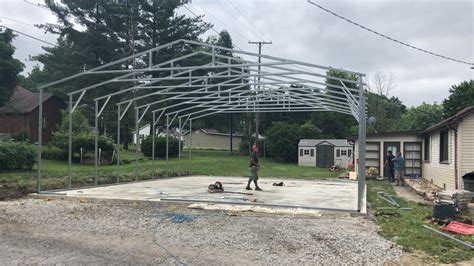Carport Anchoring: Protecting Your Vehicle & Family
Protecting your investment and ensuring the safety of your loved ones should be top priorities. A sturdy carport offers invaluable protection from the elements, but its effectiveness hinges on proper anchoring. A poorly anchored carport can become a dangerous projectile in high winds, causing significant damage and potential injury. This comprehensive guide will delve into the crucial aspects of carport anchoring, helping you make informed decisions to safeguard your vehicle and family.
Why is Carport Anchoring So Important?
Carports, while offering shade and protection from rain and snow, are vulnerable to high winds and other severe weather conditions. Without adequate anchoring, even a seemingly minor storm can lift or completely overturn your carport, resulting in:
- Vehicle Damage: Your car or other vehicles parked underneath could be severely damaged or crushed by the collapsed structure.
- Property Damage: The carport itself could damage your house, other structures, or landscaping.
- Personal Injury: A falling carport can cause serious injuries or even fatalities.
- Insurance Issues: Insufficient anchoring can void your insurance coverage in the event of damage or injury.
Therefore, proper anchoring isn't just a good idea; it's a necessity.
What are the Different Carport Anchoring Methods?
The best anchoring method depends on several factors, including the carport's size, weight, materials, and the soil conditions on your property. Common methods include:
Ground Anchors:
- Concrete Footings: This is generally considered the most secure option. Concrete footings are poured into the ground and the carport's support posts are embedded within them. This provides exceptional stability and resistance to strong winds.
- Ground Screws/Helical Piers: These are metal screws that are driven deep into the ground, providing a strong anchor point. They are a good option for various soil types and require less excavation than concrete footings.
- Anchor Bolts: These are strong bolts driven into pre-drilled holes in concrete or other solid surfaces. They offer a robust attachment point but require a pre-existing solid base.
Other Anchoring Options:
- Weight Anchors: While not a primary anchoring method, adding weight to the base of the carport can provide additional stability. This is often used in conjunction with other anchoring methods.
- Guy Wires/Cable Anchoring: These are tension wires or cables that connect the carport to sturdy anchor points further away from the structure, such as fence posts or trees. They are most effective when combined with ground anchors.
How to Choose the Right Anchoring Method for Your Carport?
Selecting the appropriate anchoring method requires careful consideration:
- Local Building Codes: Always check local building codes and regulations for specific requirements regarding carport anchoring in your area.
- Soil Conditions: The type of soil significantly impacts the effectiveness of different anchoring methods. Consult a soil expert if you're unsure about your soil type.
- Carport Size and Weight: Larger and heavier carports require more robust anchoring.
- Wind Load: Consider the typical wind speeds in your region and choose an anchoring system that can withstand these forces.
What Materials Are Best for Carport Anchoring?
The materials used for anchoring should be durable, weather-resistant, and strong enough to withstand the forces exerted on the carport. Common materials include:
- Concrete: Provides excellent strength and durability.
- Galvanized Steel: Offers corrosion resistance, essential for longevity.
- Stainless Steel: Even more corrosion-resistant than galvanized steel, ideal for harsh environments.
H2: How Deep Should Carport Anchors Be?
The required depth of carport anchors varies significantly based on the factors mentioned above. Local building codes often specify minimum depth requirements. In general, deeper is better, as it provides a more secure and stable foundation. Consult a professional to determine the appropriate depth for your specific situation.
H2: Can I Anchor a Carport Myself?
While some simpler anchoring methods can be DIY projects, particularly for smaller carports, it's highly recommended to consult with a professional, especially for larger structures or if you're unsure about the best approach. Improper anchoring can lead to serious consequences. A professional can assess your site, recommend the appropriate anchoring method, and ensure the job is done correctly and safely.
Conclusion: Prioritize Safety and Invest in Proper Anchoring
Investing in proper carport anchoring is an investment in the safety of your family, the protection of your property, and the longevity of your carport. Don't underestimate the importance of this crucial step. By understanding the different anchoring methods and seeking professional advice when needed, you can ensure your carport remains a safe and reliable shelter for years to come. Remember, a secure carport offers peace of mind, knowing your vehicle and family are protected from the elements and potential hazards.

